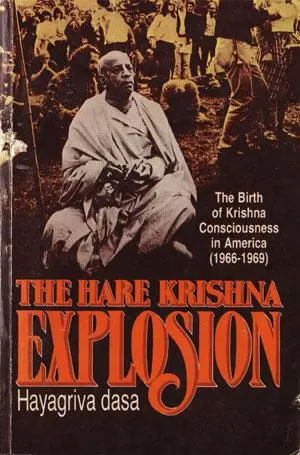05 Aug 2020
by The Hare Krishna Movement
in A.C. Bhaktivedanta Swami Prabhupada, Rudra-gita, Shiva, Uncategorized
Tags: A.C. Bhaktivedanta Swami Prabhupada, benedictions, hymn of liberation, Lord Siva, Pracetas, prayers composed by lord siva, Rudra-gita, Shiva, Siva, Srimad Bhagavatam, The Supreme Personality of Godhead, Visnu
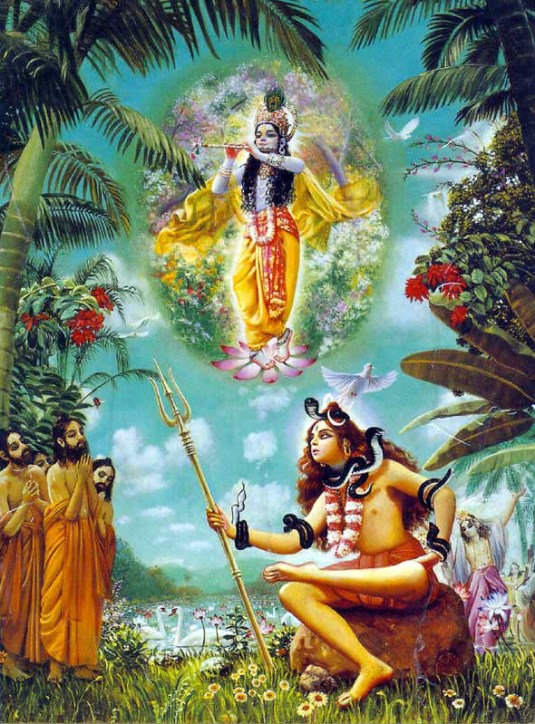
The Supreme Lord (Viṣṇu) says: “Those who will offer Me the prayers composed by Lord Śiva, both in the morning and in the evening, will be given benedictions by Me. In this way they can both fulfill their desires and attain good intelligence.” (SB 4.30.10)
Chanting the Song Sung by Lord Śiva
Lord Śiva said to the Pracetās:
“Just execute your kingly duties with a pure heart and chant the prayer I have recited, fixing your mind on the lotus feet of the Lord. That will bring you all good fortune.” (p. 405)
The Rudra-gītā is Lord Śiva’s song to the Supreme Lord, Vāsudeva (Viṣṇu) and is known as the hymn of liberation. These prayers, which are contained in Śrīmad-Bhāgavatam 4.24.33-74, are presented by Lord Śiva to the sons (Pracetās) of King Prācīnabarhi for reaching the ultimate spiritual perfection.
The Supreme Lord (Viṣṇu) says: “Those who will offer Me the prayers composed by Lord Śiva, both in the morning and in the evening, will be given benedictions by Me. In this way they can both fulfill their desires and attain good intelligence.” (SB 4.30.10)
More
18 Sep 2016
by The Hare Krishna Movement
in A.C. Bhaktivedanta Swami Prabhupada, Krsna is the Source of All Incarnations, Mohine-Murti, Srimad Bhagavatam
Tags: A. C. Bhakthvedanta Swami Prabhupada, ankle bells, beautiful woman, blackish lotus, demigods, demons, incarnation as a woman, incarnation of Krsna, mallika flowers, Mohini-murti, SB 8.8.41, SB 8.8.42, The Supreme Personality of Godhead, Visnu, youthful luster

This morning I was reading from the Srimad Bhagavatam Canto Eight, Chapter 8, entitled “The Churning of the Milk Ocean”
“…how the goddess of fortune appeared during the churning of the ocean of milk and how she accepted Lord Viṣṇu as her husband. As described later in the chapter, when Dhanvantari appeared with a pot of nectar the demons immediately snatched it from him, but Lord Viṣṇu appeared as the incarnation Mohinī, the most beautiful woman in the world, just to captivate the demons and save the nectar for the demigods.” (SB8.8Summary)
At the end of the chapter there is this beautiful description of Mohini-murti:
The Supreme Personality of Godhead, Viṣṇu, who can counteract any unfavorable situation, then assumed the form of an extremely beautiful woman. This incarnation as a woman, Mohinī-mūrti, was most pleasing to the mind. Her complexion resembled in color a newly grown blackish lotus, and every part of Her body was beautifully situated. Her ears were equally decorated with earrings, Her cheeks were very beautiful, Her nose was raised and Her face full of youthful luster. Her large breasts made Her waist seem very thin. Attracted by the aroma of Her face and body, bumblebees hummed around Her, and thus Her eyes were restless. Her hair, which was extremely beautiful, was garlanded with mallikā flowers. Her attractively constructed neck was decorated with a necklace and other ornaments, Her arms were decorated with bangles, Her body was covered with a clean sari, and Her breasts seemed like islands in an ocean of beauty. Her legs were decorated with ankle bells. Because of the movements of Her eyebrows as She smiled with shyness and glanced over the demons, all the demons were saturated with lusty desires, and every one of them desired to possess Her.
Full text and purport More
21 Nov 2014
by The Hare Krishna Movement
in A.C. Bhaktivedanta Swami Prabhupada, Adhoksaja, Buddha, Maitreya
Tags: A. C. Bhaktivedant, adhoksaja, adhoksaja means knowledge perceived by material senses, aksaja, buddha, club, conch, disk, incarnations, Krsna Is The Source of All Incarnations, Lord Adhoksaja, Lord Visnu, lotus, Maitreya, Maitreya Buddha, science of transcendence, Srimad Bhagavatam, twinty-four forms, Vidura, Vidura talks with Maitreya, Visnu

Adhokṣaja
If one were to do an image search on the Internet, of Maitreya; who is a character in the Srimad Bhagavatam, and the main person in our Previous post entitled “Vidura’s Talks with Maitreya”, the images that come up are of the Maitreya Buddha. It is interesting to note that In the Vedas, Adhokṣaja is one of the twenty-four forms of Lord Viṣṇu. Also in the Srimad Bhagavatam in the First Canto, Chapter Three, entitled “Kṛṣṇa Is the Source of All Incarnations”, Buddha is one of the incarnations to appear in this age. I thought it interesting to do a post on Adhokṣaja with some selected text from Srila Prabhupada’s books.
Maitreya Muni, who was experienced in the science of Transcendence, could understand that Vidura’s mind was fully absorbed in Transcendence. Adhokṣaja means that which transcends the limits of sense perception or sensuous experience. The Lord is transcendental to our sense experience, but He reveals Himself to the sincere devotee. Because Vidura was always absorbed in thought of the Lord, Maitreya could estimate Vidura’s transcendental value. He appreciated the valuable inquiries of Vidura and thus thanked him with great honor. (SB 3.5.18, Purport)
The Lord is explained here to be adhokṣaja, beyond the reach of all material calculation. Akṣaja means “the measurement of our senses,” and adhokṣaja means “that which is beyond the measurement of our senses.” (SB 3.19.25, Purport)
More
14 Oct 2014
by The Hare Krishna Movement
in A.C. Bhaktivedanta Swami Prabhupada, Chanting Hare Krishna, The Hare Krishna Movement, Yoga
Tags: A.C. Bhaktiveanta Swami Prabhupada, chanting Hare Krishna, God realization, Hare Rama, Hari Kirtana, Kali-yuga, kirtan, sankirtan, self relization, supreme absolute truth, Vedic literatures, Visnu

harer nāma harer nāma
harer nāmaiva kevalam
kalau nāsty eva nāsty eva
nāsty eva gatir anyathā
In this Age of Kali there is no other means, no other means, no other means for self-realization than chanting the holy name, chanting the holy name, chanting the holy name of Lord Hari.
[Adi 17.21]
…
This hari-kīrtana was started five hundred years ago in Bengal by Lord Caitanya. In Bengal there is competition between the Vaiṣṇavas and the śāktas. The śāktas have introduced a certain type of kīrtana called kālī-kīrtana. But in the Vedic scriptures there is no recommendation of kālī-kīrtana. Kīrtana means hari-kīrtana. One cannot say, “Oh, you are Vaiṣṇava. You can perform hari-kīrtana. I shall perform śiva-kīrtana or devī-kīrtana or gaṇeśa-kīrtana.” No. The Vedic scriptures do not authorize any kīrtana other than hari-kīrtana. Kīrtana means hari-kīrtana, the glorification of Kṛṣṇa.
So this process of hari-kīrtana is very simple: Hare Kṛṣṇa, Hare Kṛṣṇa, Kṛṣṇa Kṛṣṇa, Hare Hare/ Hare Rāma, Hare Rāma, Rāma Rāma, Hare Hare. Actually there are only three words: Hare, Kṛṣṇa, and Rāma. But they are very nicely arranged for chanting so that everyone can take the mantra and chant Hare Kṛṣṇa, Hare Kṛṣṇa, Kṛṣṇa Kṛṣṇa, Hare Hare. Since we have started this movement in the Western countries, Europeans, Americans, Africans, Egyptians, and Japanese are all chanting. There is no difficulty. They are chanting very gladly, and they are getting the results. What is the difficulty? We are distributing this chanting free of charge, and it is very simple. Simply by chanting, one can have self-realization, God realization, and when there is God realization, then nature realization is included also. (from The Science of Self Realization)
More
10 Oct 2013
by The Hare Krishna Movement
in A.C. Bhaktivedanta Swami Prabhupada
Tags: A.C. Bhaktivedanta Swami Prabhupada, Arjuna, as it is, Bhagavad-gita As It Is, Brahma, Candra, demigods, faith, goodness, ignorance, Indra, Krishna, krsna consciousness, passion, sattva, Siva, Spiritual Life, Srila Prabhupada, sun-god, The Divisions of Faith, Visnu

click on image to enlarge
Bhagavad-gītā As It Is 1972 Edition
by His Divine Grace A. C. Bhaktivedanta Swami Prabhupāda
Chapter Seventeen
The Divisions of Faith
More
05 Jul 2013
by The Hare Krishna Movement
in A.C. Bhaktivedanta Swami Prabhupada, Spiritual World, Teachings of Lord Chaitanya
Tags: A.C. Bhaktivedanta Swami Prabhupada, Aniruddha, Damodara, devotees, four-handed, Hrsikesa, Krsna, Madhava, Madhusudana, Narayana, Padmanabha, prabhava form, Pradyumna, Sankarsana, spiritual sky, Sridhara, Teachings of Lord Chaitanya, Trivikrama, universe, vaisnava calendar, Vamana, Vasudeva, vilasa-murti, Visnu

click on image
Sometime back I ran across this picture and saved it to my files thinking I could use it in a post someday. While posting this chapter from the Teachings of Lord Caintanya, entitled “Unlimited Forms of Godhead”, I was looking for an image to use. So I selected the above image and to my surprise when I clicked on it, it moved. I had forgotten how cheesy cool this image was, and why it captured my interest, back when I saved it. So we share it today with our readers, and thank the unknown artist who put this picture to life.
…The different forms of Kṛṣṇa are distributed throughout the universe to give pleasure to the devotees. It is not that devotees are born only in India. There are devotees in all parts of the world, but they have simply forgotten their identity. These forms incarnate not only to give pleasure to the devotee but to reestablish devotional service and perform other activities which vitally concern the Supreme Personality of Godhead.
Teachings of Lord Chaintanya
By His Divine Grace A.C. Bhaktivedanta Swami Prabhupada
Chapter Seven
More
03 Apr 2013
by The Hare Krishna Movement
in A.C. Bhaktivedanta Swami Prabhupada, Ajamila, Back to Godhead, Srimad Bhagavatam
Tags: A.C. Bhaktivedanta Swami Prabhupada, Back to Godhead Magazine, Hare Krishna, Narayana, servants of Yamaraja, Supreme Lord Visnu, Visnu, Visnudutas, yamadutas

click image to enlarge
…At the time of death, Ajamila helplessly and very loudly chanted the holy name of the Lord. That chanting alone has already freed him from the reactions of all sinful life. One who chants the holy name is immediately freed from the reactions of unlimited sins, even if he chants indirectly to indicate something else, jokingly, for musical entertainment, or even neglectfully. This is accepted by all the learned scholars of the scriptures. If one chants the holy name of Hari and then dies because of an accidental misfortune, one is immediately absolved from having to enter hellish life, even though he is sinful.
Full Story More
03 Oct 2012
by The Hare Krishna Movement
in A.C. Bhaktivedanta Swami Prabhupada, Mohine-Murti, Srimad Bhagavatam
Tags: A.C. Bhaktivedanta Swami Prabhupada, ankle bells, blackis lotus, bumblebees, demigods, demons, incarnation as a woman, lusty desires, mallika flowers, Mohini-murti, Srila Prabhupada, The Supreme Personality of Godhead, Visnu

The following is from the Srimad Bhagavatam, Eight Canto, Chapter Nine, entitled “The Lord Incarnates as Mohinī-Mūrti”. The full chapter follows this beautiful verse from preceding chapter.
The Supreme Personality of Godhead, Viṣṇu, who can counteract any unfavorable situation, then assumed the form of an extremely beautiful woman. This incarnation as a woman, Mohinī-mūrti, was most pleasing to the mind. Her complexion resembled in color a newly grown blackish lotus, and every part of Her body was beautifully situated. Her ears were equally decorated with earrings, Her cheeks were very beautiful, Her nose was raised and Her face full of youthful luster. Her large breasts made Her waist seem very thin. Attracted by the aroma of Her face and body, bumblebees hummed around Her, and thus Her eyes were restless. Her hair, which was extremely beautiful, was garlanded with mallikā flowers. Her attractively constructed neck was decorated with a necklace and other ornaments, Her arms were decorated with bangles, Her body was covered with a clean sari, and Her breasts seemed like islands in an ocean of beauty. Her legs were decorated with ankle bells. Because of the movements of Her eyebrows as She smiled with shyness and glanced over the demons, all the demons were saturated with lusty desires, and every one of them desired to possess Her. (SB 8.8.41-48)
Because of the Supreme Lord’s assuming the form of a beautiful woman to arouse the lusty desires of the demons, a description of Her complete beauty is given here.
More
16 Jul 2012
by The Hare Krishna Movement
in A.C. Bhaktivedanta Swami Prabhupada, Meditation, Srimad Bhagavatam, Visnu, Yoga
Tags: A.C. Bhaktivedanta Swami Prabhupada, Absolute Truth, impersonal conception of the Absolute Truth, Lord Visnu, material energy, pantheism, Personality of Godhead, Srimad Bhagavatam, Visnu
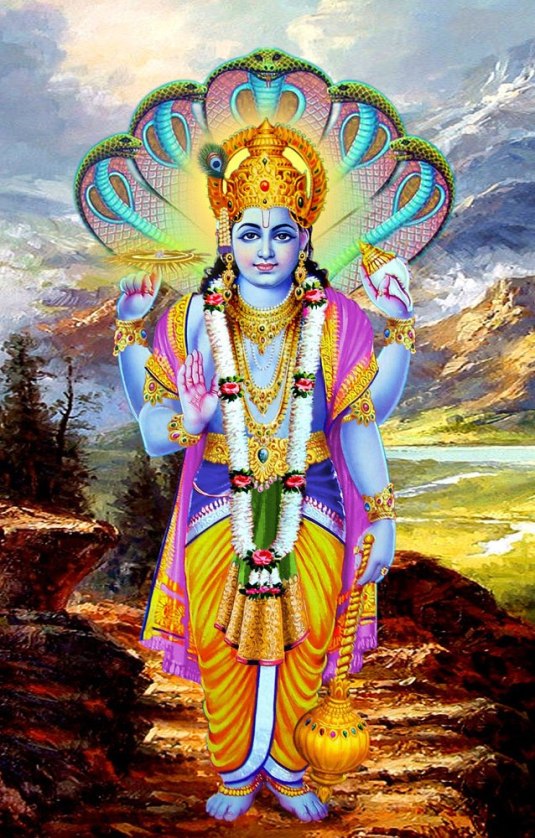
In our previous post Fix your mind upon the Supreme Personality of Godhead it was recommended that we should fix one’s mind in the service of the Personality of Godhead. Now the next step is to meditate upon the form of the Lord. To move from the impersonal to the more personal aspects of the Absolute Truth.
Thereafter, you should meditate upon the limbs of Viṣṇu, one after another, without being deviated from the conception of the complete body. Thus the mind becomes free from all sense objects. There should be no other thing to be thought upon. Because the Supreme Personality of Godhead, Viṣṇu, is the Ultimate Truth, the mind becomes completely reconciled in Him only.
…Therefore, thinking of Viṣṇu or meditating upon the transcendental form of Viṣṇu, specifically upon Lord Kṛṣṇa, is the last word on the subject of meditation.
…it is definitely assured that the Supreme Lord is not impersonal. He is a person, but His body is different from those of conditioned persons like us. Otherwise, meditation beginning from the praṇava (oṁkāra) up to the limbs of the personal body of Viṣṇu would not have been recommended by Śukadeva Gosvāmī for the attainment of complete spiritual perfection. The Viṣṇu forms of worship in great temples of India are not, therefore, arrangements of idol worship, as they are wrongly interpreted to be by a class of men with a poor fund of knowledge; rather, they are different spiritual centers of meditation on the transcendental limbs of the body of Viṣṇu. The worshipable Deity in the temple of Viṣṇu is identical with Lord Viṣṇu by the inconceivable potency of the Lord.
More
16 Jan 2012
by The Hare Krishna Movement
in Bhagavad-gita, Krishna
Tags: A.C. Bhaktivedanta Swami Prabhupada, Atlas, Atlas holding the globe, Bg 9.5, Bhagavad-gita As It Is, creation, material manifestation, Spiritual world, Visnu
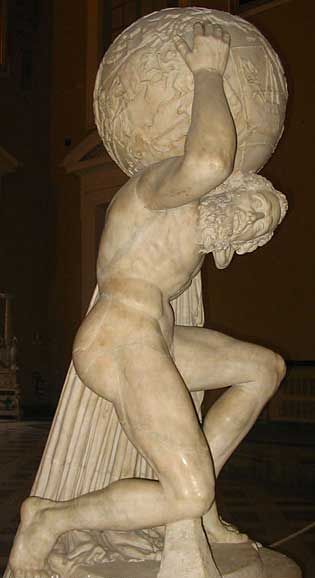
The Lord says that everything is resting on Him. This should not be misunderstood. The Lord is not directly concerned with the maintenance and sustenance of this material manifestation. Sometimes we see a picture of Atlas holding the globe on his shoulders; he seems to be very tired, holding this great earthly planet. Such an image should not be entertained in connection with Kṛṣṇa’s upholding this created universe. He says that although everything is resting on Him, still He is aloof.

Bhagavad-gita As It Is – Macmillan 1972 Edition
By His Divine Grace A.C. Bhaktivedanta Swami Prabhupada
Chapter 9, Text 5
na ca mat-sthāni bhūtāni
paśya me yogam aiśvaram
bhūta-bhṛn na ca bhūta-stho
mamātmā bhūta-bhāvanaḥ
na—never; ca—also; mat-sthāni—situated in Me; bhūtāni—all creation; paśya—just see; me—My; yogam aiśvaram—inconceivable mystic power; bhūta-bhṛt—maintainer of all living entities; na—never; ca—also; bhūta-sthaḥ—in the cosmic manifestation; mama—My; ātmā—Self; bhūta-bhāvanaḥ—is the source of all manifestations.
Translation
And yet everything that is created does not rest in Me. Behold My mystic opulence! Although I am the maintainer of all living entities, and although I am everywhere, still My Self is the very source of creation.
More
21 Oct 2011
by The Hare Krishna Movement
in Songs of the Vaisnava Acaryas, Sri Damodarastakam, Visnujana Swami
Tags: Damorara, Lord Sri Damodara, Sri Damodarastakam, Visnu, Visnujana Swami
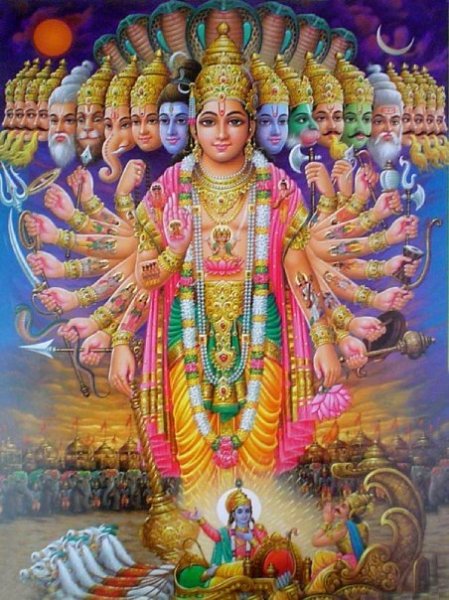
O unlimited Visnu! O master! O Lord!
namo deva dāmodarānanta viṣṇo
prasīda prabho duḥkha-jālābdhi-magnam
kṛpā-dṛṣṭi-vṛṣṭyāti-dīnaḿ batānu
gṛhāṇeṣa mām ajñam edhy akṣi-dṛśyaḥ
namaḥ–I bow down; deva–O divine Lord!; dāmodara–O Lord whose belly is bound with a rope!; ananta–O limitless Lord!; viṣṇo–O allpervading Lord!; prasīda–be pleased; prabho–O my Master!; duḥkhajāla–a network of material miseries; abdhi-magnam–immersed in the ocean; kṛpā-dṛṣṭi-vṛṣṭyā–by the rain of merciful glances; āti-dīnam–very fallen; bata–alas!; anugṛhāṇa–please accept; īśa–O supremely independent Lord!; mām–me; ajñam–ignorant; edhi–please come; akṣidṛśyaḥ–perceptible to my eyes.
6) O unlimited Visnu! O master! O Lord! Be pleased upon me! I am drowning in and ocean of sorrow and am almost like a dead man, Please shower the rain of mercy on me; uplift me and protect me with Your nectarean vision.
Purport
Feelings of love arise from the purity and potency of longing, and then is only satisfied to behold the beauty of Sri Krishna directly (saksat darsana). The supreme method (param-sadhana) to attain this goal is chanting the Holy Name (sri-nama-sankirtana). Satyavrata Muni begins this verse chanting the Holy Names. In his ecstasy, feelings of awe and reverence are abandoned by the elimination of the word tubhyam (unto You). This creates the mood of being in the personal presence of the Lord.
More
























